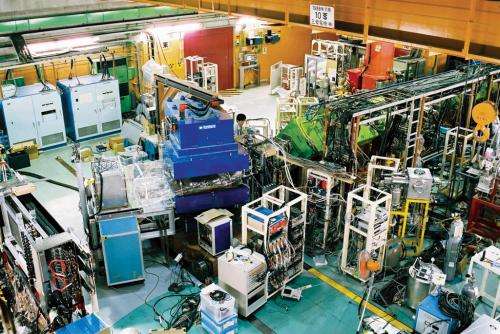Oxygen nucleus with twice as many neutrons as normal is shown to be surprisingly stable

The nucleus at the heart of an atom is held together by a subtle balance between the nuclear force that binds protons and neutrons and the electric repulsion that tries to fling the positively charged protons apart. Understanding how the number of nucleons—the collective term for protons and neutrons—affects this balance is crucial for predicting nuclear processes such as radioactive decay. RIKEN researchers, working as part of an international team, have now shown that 'heavy' oxygen nuclei with 16 neutrons form into a solid ball, which makes them unexpectedly stable.
More than 99% of the oxygen in the Earth's atmosphere is in its most stable form with eight protons and eight neutrons at the center. However, scientists can create neutron-heavy versions, or isotopes, in the laboratory to help them better understand what happens in a nucleus. Tohru Motobayashi from the RIKEN Nishina Center for Accelerator-Based Science, collaborating with Yoshinori Satou from the Seoul National University, Korea, Takashi Nakamura from the Tokyo Institute of Technology, Japan, and co-workers from France, Hungary and China have now performed the first spectroscopic study of oxygen nuclei with 16 neutrons using a technique known as proton inelastic scattering. They fired a beam of these oxygen-24 atoms at a liquid-hydrogen target, and then extracted the properties of the neutron-rich nuclei by tracking the direction and speed of the particles after the collision.
A nucleus has either a spherical or elliptical shape depending on the number of neutrons and protons. "The nucleus is more stable and solid when it is spherical," explains Motobayashi. "In our experiments we can hear the sound associated with this solidity, just as you can when you strike an everyday solid object."
An intriguing aspect of this result is that it runs contrary to the now well-established observation that nuclei are usually stable when the number of neutrons and protons corresponds to a so-called magic number: 2, 8, 20, 28, 50, 82 or 126. "We can now confirm that a neutron number of 16 is magic when proton and neutron numbers are largely unbalanced," says Motobayashi. "This supports other recent experiments on different nuclei."
This cutting edge experiment is another example of the importance of the steadily growing research collaboration between RIKEN, the Tokyo Institute of Technology and a number of Korean universities. "We next hope to explore more neutron-rich oxygen isotopes with 17, 18 or more neutrons to see if another stable oxygen nucleus exists," says Motobayashi.
More information: Tshoo, K., Satou, Y., Bhang, H., Choi, S., Nakamura, T., Kondo, Y., Deguchi, S., Kawada, Y., Kobayashi, N., Nakayama Y. et al. N = 16 spherical shell closure in 24O. Physical Review Letters 109, 022501 (2012). prl.aps.org/abstract/PRL/v109/i2/e022501
Journal information: Physical Review Letters
Provided by RIKEN



















